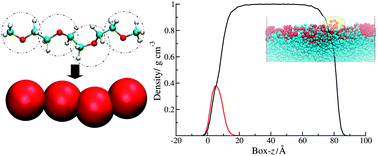A coarse-grained model for polyethylene glycol in bulk water and at a water/air interface†
Abstract
A coarse-grained model for polyethylene glycol (PEG) in

* Corresponding authors
a
Department of Chemistry, Durham University, South Road, Durham, UK
E-mail:
mark.wilson@durham.ac.uk
b Department of Chemistry, Faculty of Science, Mahasarakham University, Maha Sarakham 44150, Thailand
A coarse-grained model for polyethylene glycol (PEG) in

 Please wait while we load your content...
Something went wrong. Try again?
Please wait while we load your content...
Something went wrong. Try again?
K. Prasitnok and M. R. Wilson, Phys. Chem. Chem. Phys., 2013, 15, 17093 DOI: 10.1039/C3CP52958D
To request permission to reproduce material from this article, please go to the Copyright Clearance Center request page.
If you are an author contributing to an RSC publication, you do not need to request permission provided correct acknowledgement is given.
If you are the author of this article, you do not need to request permission to reproduce figures and diagrams provided correct acknowledgement is given. If you want to reproduce the whole article in a third-party publication (excluding your thesis/dissertation for which permission is not required) please go to the Copyright Clearance Center request page.
Read more about how to correctly acknowledge RSC content.
 Fetching data from CrossRef.
Fetching data from CrossRef.
This may take some time to load.
Loading related content
